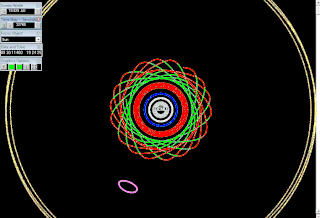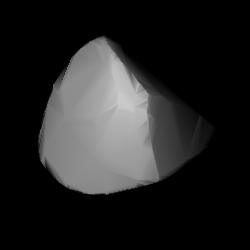Related Research Articles
2934 Aristophanes, provisional designation 4006 P-L, is a carbonaceous Veritasian asteroid from the outer regions of the asteroid belt, approximately 22 kilometers in diameter. It was discovered during the Palomar–Leiden survey in 1960, and later named after ancient Greek dramatist Aristophanes.
2598 Merlin, provisional designation 1980 RY, is a carbonaceous Dorian asteroid from the central regions of the asteroid belt, approximately 16 kilometers in diameter. It was discovered on 7 September 1980, by American astronomer Edward Bowell at Lowell's Anderson Mesa Station in Flagstaff, Arizona, United States. The asteroid was named after the legendary wizard Merlin in Arthurian legend.

1840 Hus is a stony Koronis asteroid from the outer regions of the asteroid belt, approximately 12.5 kilometers in diameter. It was discovered on 26 October 1971, by Czech astronomer Luboš Kohoutek at the Bergedorf Observatory in Hamburg, Germany. The S-type asteroid has a rotation period of 4.8 hours and is likely elongated in shape. It was later named after 15th-century theologian Jan Hus.
3563 Canterbury, provisional designation 1985 FE, is a dark Dorian asteroid from the middle regions of the asteroid belt, approximately 16 kilometers in diameter. It was discovered on 23 March 1985, by astronomer couple Alan Gilmore and Pamela Kilmartin at Mount John University Observatory near Lake Tekapo, New Zealand. The asteroid was named after New Zealand's Canterbury Province.
7803 Adachi, provisional designation 1997 EW2, is a stony Agnia asteroid from the middle region of the asteroid belt, approximately 6.4 kilometers (4 miles) in diameter. The asteroid was discovered on 4 March 1997, by Japanese amateur astronomer Takao Kobayashi at the Ōizumi Observatory in central Japan. It was named for Japanese amateur astronomer Makoto Adachi. The S-type asteroid has a rotation period of 5.2 hours.
Bacon, provisional designation 3042 P-L, is a carbonaceous Dorian asteroid from the central region of the asteroid belt, approximately 9 kilometers in diameter. It was discovered on 24 September 1960, by Ingrid and Cornelis van Houten at Leiden, and Tom Gehrels at Palomar Observatory in California, United States. It was later named after English philosopher and statesman Francis Bacon.

2708 Burns is a carbonaceous Themistian asteroid from the outer regions of the asteroid belt, approximately 19 kilometers in diameter. It was discovered on 24 November 1981, by American astronomer Edward Bowell at the Anderson Mesa Station near Flagstaff, Arizona, in the United States. It was named after American planetary scientist Joseph A. Burns. The likely elongated B-type asteroid has a rotation period of 5.3 hours.
1253 Frisia, provisional designation 1931 TV1, is a carbonaceous Themistian asteroid from the outer regions of the asteroid belt, approximately 20 kilometers in diameter. Discovered by Karl Reinmuth at Heidelberg Observatory in 1931, the asteroid was later named after the region of Frisia and the Frisian Islands.

5222 Ioffe, provisional designation 1980 TL13, is a rare-type carbonaceous Palladian asteroid from the central region of the asteroid belt, approximately 18 kilometers in diameter. It was discovered on 11 October 1980, by Soviet astronomer Nikolai Chernykh at the Crimean Astrophysical Observatory in Nauchnyj, Crimea. It is the largest of the Palladian asteroids apart from Pallas itself.

1836 Komarov is a carbonaceous Dorian asteroid from the central region of the asteroid belt, approximately 22 kilometers in diameter. It was discovered on 26 July 1971 by Russian astronomer Nikolai Chernykh at Crimean Astrophysical Observatory in Nauchnij on the Crimean peninsula. It was named after Soviet cosmonaut Vladimir Komarov.
3963 Paradzhanov, provisional designation 1969 TP2, is a Nysian asteroid from the inner regions of the asteroid belt, approximately 6 kilometers in diameter. It was discovered on 8 October 1969, by astronomer Lyudmila Chernykh at the Crimean Astrophysical Observatory in Nauchnyj, on the Crimean peninsula. The asteroid was named after Soviet film director Sergei Parajanov (Sargis Paradzhanov) in 1996.
3790 Raywilson, provisional designation 1937 UE, is a carbonaceous Themistian asteroid from the outer regions of the asteroid belt, approximately 12 kilometers in diameter. It was discovered on 26 October 1937, by astronomer Karl Reinmuth at the Heidelberg-Königstuhl State Observatory in Heidelberg, Germany. The C-type asteroid has a rotation period of 4.65 hours. It was named for English physicist Raymond Wilson.

2384 Schulhof (prov. designation: 1943 EC1) is a mid-sized asteroid and the namesake of the Schulhof family, located in the Eunomian region of the intermediate asteroid belt. It was discovered on 2 March 1943, by French astronomer Marguerite Laugier at Nice Observatory in southeastern France. The asteroid was later named after Hungarian astronomer Lipót Schulhof. The presumed S-type asteroid has a short rotation period of 3.3 hours and measures approximately 12 kilometers (7.5 miles) in diameter.
2169 Taiwan, provisional designation 1964 VP1, is a carbonaceous Astridian asteroid from the central regions of the asteroid belt, approximately 17 kilometers in diameter. It was discovered on 9 November 1964, by astronomers at the Purple Mountain Observatory near Nanking, China. It was named for Taiwan.

3962 Valyaev is a dark Themistian asteroid from the outer region of the asteroid belt. The presumed C-type asteroid has a rotation period of 16.4 hours and measures approximately 15 kilometers in diameter. It was discovered on 8 February 1967, by Russian astronomer Tamara Smirnova at Nauchnyj on the Crimean peninsula, and later named after Russian astronomer Valerij Valyaev.
1734 Zhongolovich, provisional designation 1928 TJ, is a carbonaceous Dorian asteroid from the central region of the asteroid belt, approximately 28 kilometers in diameter.
21873 Jindřichůvhradec, provisional designation 1999 UU3, is a dark Hygiean asteroid and relatively slower-than average rotator from the outer region of the asteroid belt, approximately 8 kilometers (5.0 miles) in diameter.
10241 Miličević, provisional designation 1999 AU6, is a carbonaceous Themistian asteroid from the outer regions of the asteroid belt, approximately 11 kilometers (6.8 miles) in diameter. It was discovered on 9 January 1999, by Croatian astronomer Korado Korlević at the Višnjan Observatory in Croatia. The C-type asteroid has a short rotation period of 3.87 hours and was named after hermit and amateur astronomer Don Nikola Miličević.

7835 Myroncope is an asteroid of the Mitidika family from the central region of the asteroid belt. It was discovered on 16 June 1993, by American astronomer Timothy Spahr at the Catalina Station in Arizona, United States. The assumed S-type asteroid has a rotation period of 7.4 hours and measures approximately 10 kilometers in diameter. It was named in memory of American sports announcer Myron Cope (1929–2008).
31179 Gongju, provisional designation 1997 YR2, is a stony Nysian asteroid from the inner regions of the asteroid belt, approximately 5 kilometers (3 miles) in diameter. It was discovered on 21 December 1997, by Japanese amateur astronomer Naoto Sato at his Chichibu Observatory near Tokyo, central Japan. The S-type asteroid has a rotation period of 4.8 hours and possibly an elongated shape. It was named for the South Korean city of Gongju.
References
- 1 2 3 4 5 6 7 "JPL Small-Body Database Browser: 2807 Karl Marx (1969 TH6)" (2017-03-29 last obs.). Jet Propulsion Laboratory . Retrieved 14 June 2017.
- 1 2 3 Schmadel, Lutz D. (2007). "(2807) Karl Marx". Dictionary of Minor Planet Names. Springer Berlin Heidelberg. p. 230. doi:10.1007/978-3-540-29925-7_2808. ISBN 978-3-540-00238-3.
- 1 2 3 "2807 Karl Marx (1969 TH6)". Minor Planet Center. Retrieved 30 November 2016.
- 1 2 Broz, M.; Morbidelli, A.; Bottke, W. F.; Rozehnal, J.; Vokrouhlický, D.; Nesvorný, D. (March 2013). "Constraining the cometary flux through the asteroid belt during the late heavy bombardment". Astronomy and Astrophysics. 551: 16. arXiv: 1301.6221 . Bibcode:2013A&A...551A.117B. doi:10.1051/0004-6361/201219296.
- 1 2 3 Masiero, Joseph R.; Mainzer, A. K.; Grav, T.; Bauer, J. M.; Cutri, R. M.; Dailey, J.; et al. (November 2011). "Main Belt Asteroids with WISE/NEOWISE. I. Preliminary Albedos and Diameters". The Astrophysical Journal. 741 (2): 20. arXiv: 1109.4096 . Bibcode:2011ApJ...741...68M. doi:10.1088/0004-637X/741/2/68 . Retrieved 6 November 2016.
- ↑ Nesvorný, D.; Broz, M.; Carruba, V. (December 2014). "Identification and Dynamical Properties of Asteroid Families". Asteroids IV. pp. 297–321. arXiv: 1502.01628 . Bibcode:2015aste.book..297N. doi:10.2458/azu_uapress_9780816532131-ch016. ISBN 978-0-8165-3213-1.
- ↑ "LCDB Data for (2807) Karl Marx". Asteroid Lightcurve Database (LCDB). Retrieved 14 June 2017.
- ↑ "MPC/MPO/MPS Archive". Minor Planet Center. Retrieved 30 November 2016.